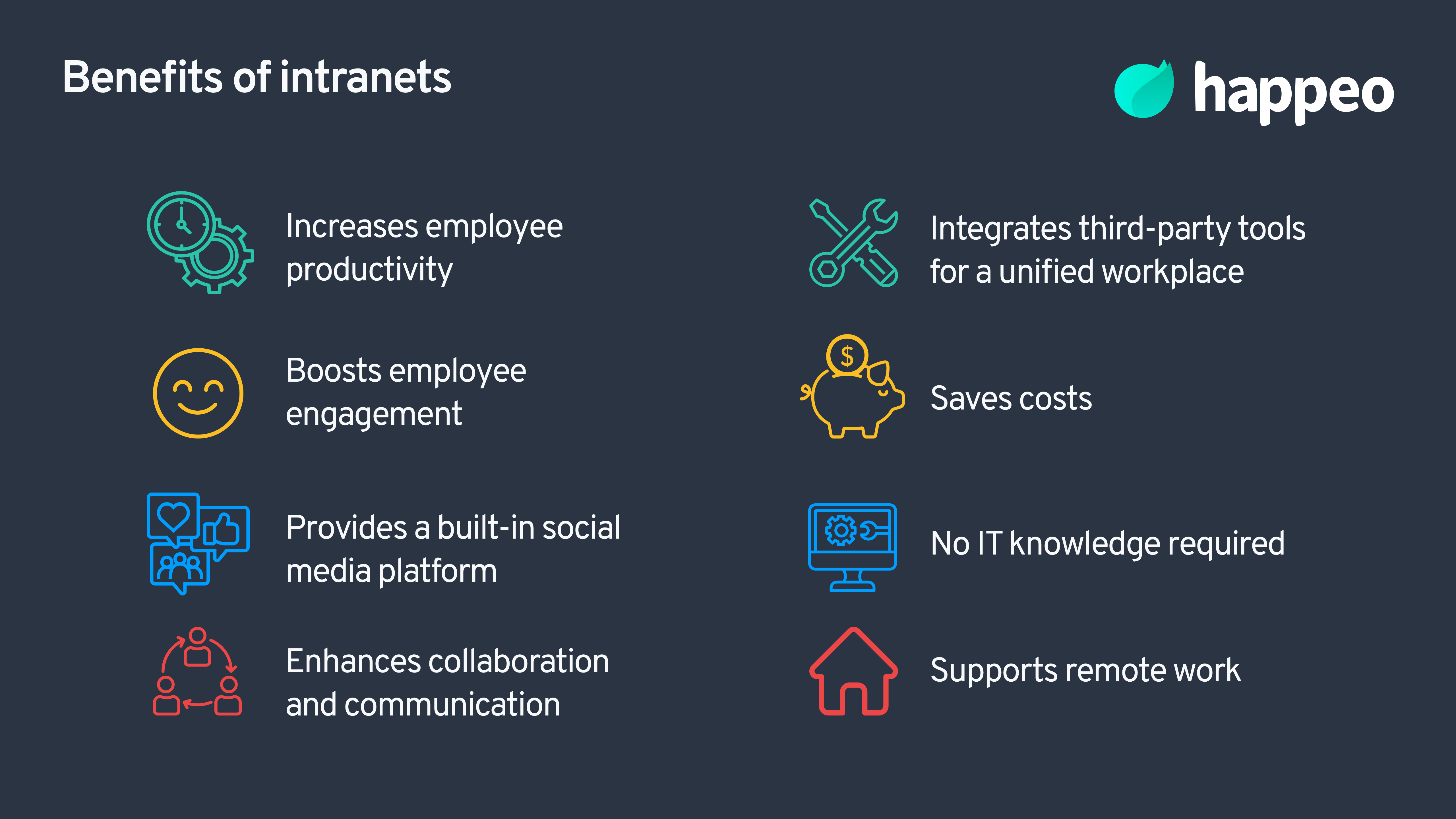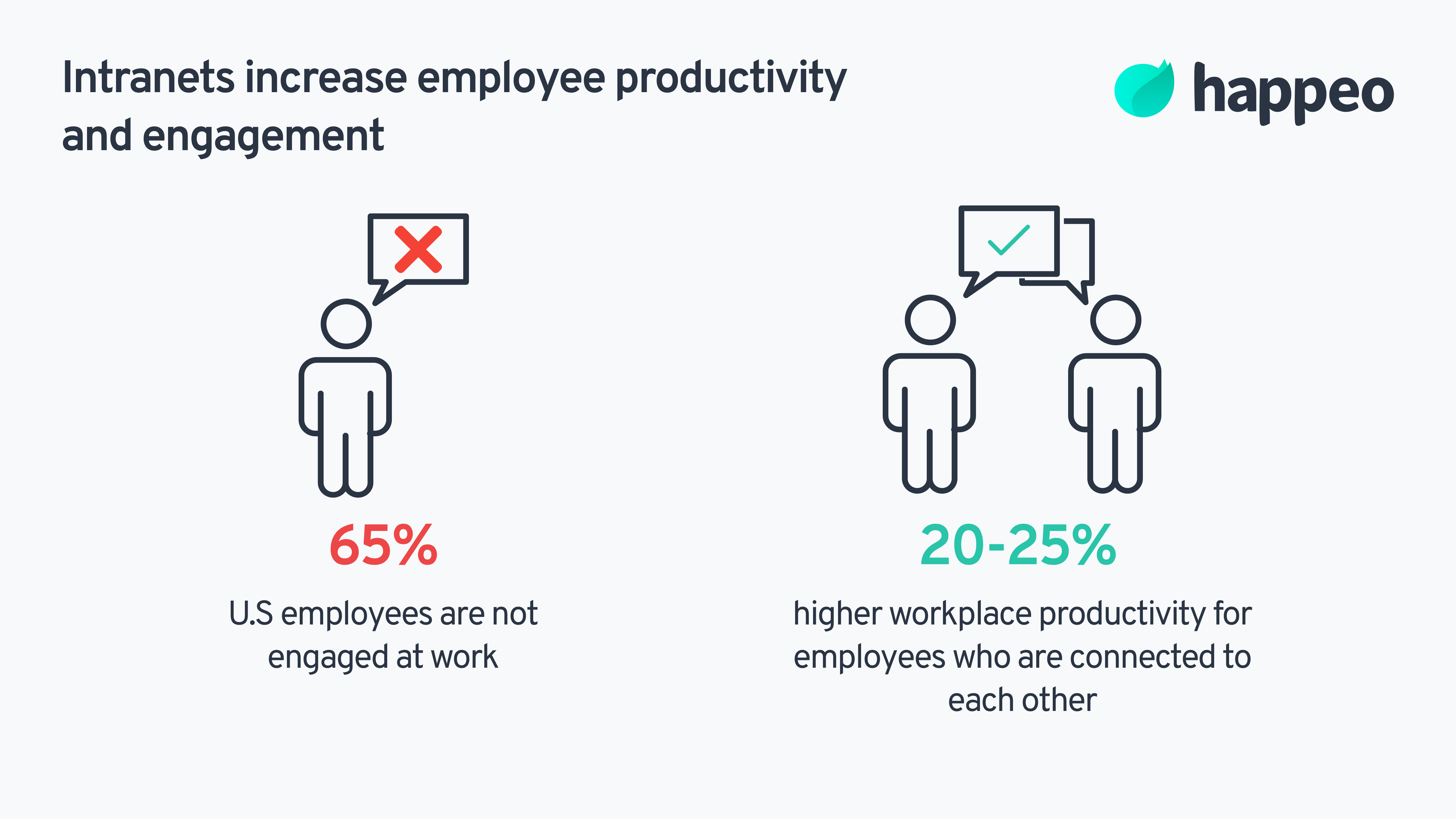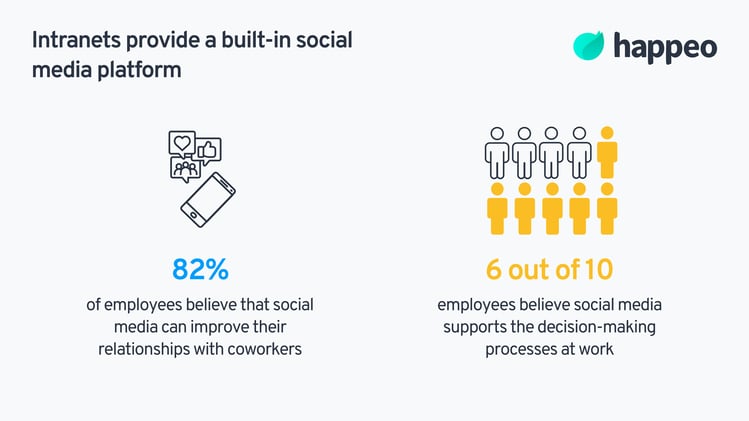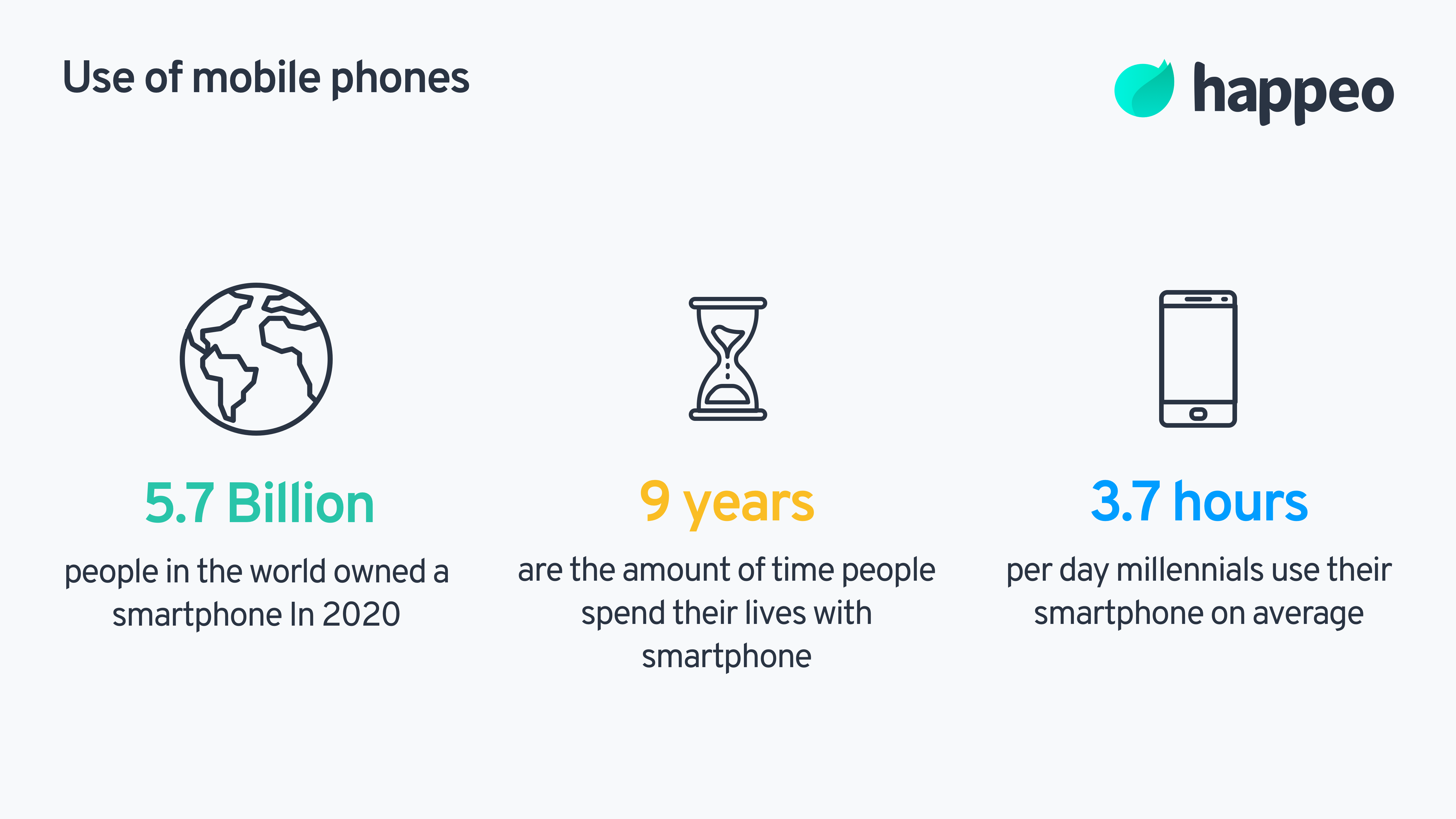

Jonathan Davies
13 mins read
Start building your digital home with Happeo
Request a demoSifting through all of the information out there about the latest and the best in intranet software can be overwhelming.
So overwhelming, in fact, that it becomes confusing and unhelpful. All of the options, questions, assessments, and facts can make it difficult to know whether or not your company is ready for an intranet portal.
What are the advantages and disadvantages of an intranet?
Intranets have some great features that allow companies to be more productive. Although intranets have several advantages, some disadvantages still make them less attractive for some organizations. In this article, we will explore some distinctive benefits and potential drawbacks of intranets, so you can decide whether it’s the right solution for your company.
Advantages of intranets
- Increases employee productivity and engagement
Using an intranet at work comes with several benefits for employees and management. One of the most important ones is the increase in productivity and employee engagement. Implementing an employee intranet portal is going to unify your workforce and invite your employees into a space where their voice can be heard and their opinions can be known. A study by Gallup showed that 65% of U.S. employees are not engaged at work. Another study by The McKinsey Global Institute recently concluded that productivity increases 20-25% in companies that have employees who are connected to each other, and to the company. This increase in productivity can produce real ROI for your company, ultimately saving you revenue just by providing a platform for your employees to connect. This platform also provides everything your employees will need to get their job done in one central hub, eliminating the constant need to switch to different platforms – another productivity increase.
What will connect and engage your employees in an employee intranet portal is the opportunity for user-generated content. The benefit of an intranet is that it creates an interactive space for employees to contribute. Gone are the old-fashioned days of sending a static message down from corporate to the masses, instead modern intranet portal solutions facilitate two-way conversations between employees from every department. Creative or opinionated employees looking for a way to express themselves will now have a way to do so, which will improve satisfaction and keep your intranet portal relevant. Continual and instant updates will also keep employees constantly checking and interacting with the intranet.
- Provides a built-in social media platform
The digital world is run by social media, so incorporating relevant characteristics of social media platforms can have huge benefits in your employee intranet portal. Allowing a space for employees to connect with each other builds relationships within the workplace, which can lead to overall employee satisfaction. Internal networking also helps complete tasks. Studies show that 82% of employees believe that social media can improve their relationships with coworkers and 60% of employees believe social media supports the decision-making processes at work. A so called social intranet software can meet the social needs of your employees through coordinating events, congratulating each other on successes, or simply sharing information with one another.
The Harvard Business Review found that “social media inside the enterprise and out lower the costs and increase the power of individuals to productively coalesce and coordinate on their own initiative.” Elements such as personalized profiles for each employee, with a searchable homepage and social media reactions (likes, comments, @mentions), are going to empower your employees to connect. It also fosters a sense of community and relationship in the workplace.
- Enhances collaboration and communication
Another intranet benefit is the space it provides for improved employee collaboration, teamwork and communication. Elements that allow for document sharing, commenting, and editing give employees an opportunity to work on projects together, no matter their physical distance. While an efficient employee intranet portal will have specific spaces for each department to share information and collaborate on tasks, it will also facilitate cross-departmental communication, which helps unlock the wealth of knowledge that can be left undiscovered with poor company communication and collaboration.
The inherit focus that company intranet portals place on communication also leads to more transparency in the workplace, and it lets your employees know that effective communication is a top concern to your enterprise.
How does an intranet software work?
Watch video
- Integrates outside tools
While intranet portals come with a multitude of product features, really they are meant to be seen as a hub to house every tool your company uses and needs. A huge benefit to implementing an intranet software is that it can integrate all of the tools your company is currently using and bring them together in one space. Whatever applications you may currently be using for company efficiency and productivity - i.e. Google Workspace (formerly G Suite), Skype, Yammer, Slack, or Trello - can all be incorporated into your employee intranet portal. A Google intranet solution is the recommended intranet portal for companies that already use Google Workspace.
If you already have all of these tools and they work well for you, one somewhat hidden intranet advantage when integrating your tools into a larger system is the break down of silos. When you have so many different tools that aren’t integrated, the data that exists in those systems exists separately from everything else happening in the enterprise. This means information can easily be lost or duplicated between platforms. Bringing these tools together means the information they hold is brought together as well, and data becomes streamlined and efficient. Integrating tools also improves productivity by cutting down the time it takes to continually switch between other platforms. Instead, employees can complete tasks from start to finish, all inside the intranet portal.
- Allows for software customization
Another advantage of intranet portals are, they allow you to customize your solution to fit your exact business needs. With so many tools and solutions available in employee intranet portals you can identify your specific needs and build your an intranet portal around them. That way you are left with all of what you need and nothing that you don’t. You can also brand your intranet software, which helps unify your company and sets an example for formatting to your employees. Most intranet providers can tweak their software to fit your needs, so don’t be afraid to ask before implementing.
Each enterprise has a specific way of conducting business, and a customizable intranet allows you to tailor your content accordingly. Another intranet benefit is that after it’s successfully built, your employees should be able to customize the software themselves without the consultation of experts or IT. The new age of intranets are fluid, functional, and evolve alongside your organization.
- Includes document storage
Employees can waste countless of hours when using an outdated content and knowledge management system. They get lost trying to remember where a document or piece of information was stored, or search through a mountain of files trying to find it. The benefit an intranet plays in this scenario is that all data and documents are stored in one place. With an effective search engine, all your employees need to do is search across the intranet portal to find what they are looking for. This will increase productivity and streamline data management across the board.
Not only can essential working documents become more accessible, but things like your employee handbook and PTO forms can be stored in an obvious, effective manner. Employees can become more self-sufficient with this type of knowledge at their fingertips, which frees up other employees to do their jobs as well. And, if all your content and documentation is stored well under one “roof”, it will provide a wealth of knowledge to your employees for whatever research or information they may need to complete a task.
Discover all the features of an intranet software
Download list
- Available anytime, anyplace
Once your company implements an intranet portal for employees, they can log in and access it from any device with internet access, at any time. They are no longer tied to a desktop computer at the office, because with cloud-based portals everything is available everywhere. This is a huge advantage and perfect solution for those employees who are constantly on-the-go, traveling for your business.
In keeping with the mobile theme, most intranets offer a mobile intranet app as well. Why? Because organizations know how much time people spend on their mobile phones. In 2020 more than 5.7 billion people in the world owned a smartphone. A study shows that people spend over 76,500 hours of their lives using their mobiles, which are almost 9 years. The study also reveals that Millennials are using the mobile phones most with 3.7 hours per day.
Using a mobile app means information and updates can be sent out company-wide. They also instantly show up on employee’s phones through notifications. Employees stay connected with business happenings, and they can also stay connected to the workplace through personalized news feeds and social media tools on the mobile app.
Disadvantages of intranets
- Breach in security
Although intranet portals come with a lot of advantages because they are a great way to collaborate, they also come with some disadvantages. One of the most important one is intranet security. Anytime you are collecting all your most important data and information in one place, you are putting it all at risk. Intranet providers go to great lengths to make sure their intranet systems are secure, but a system via gateway or firewall must be in place. You also need to set up defined policies and processes within your company for intranet use. You need an intranet ‘Code of Conduct’ so the organization is one page when it comes to the use of your new intranet portal.
- Overload of information
Too much information can be a bad thing. While successful intranets should set up an organized information management system, a challenge with intranet software can be managing and storing an overload of information on the platform. Excessive amounts of information or content can lead to confusion and counter productivity in employees. If employees feel overwhelmed by the amount of content on the intranet portal, they are more likely to avoid it. Without organization, you will be right back where you were before implementing your intranet – sifting through endless data and documents in search of what you need.
- Timely and costly
Another disadvantage of intranets are time management and costs. While many employee intranet portals advertise a quick and easy implementation, every company is different. It’s a challenge with employee intranet portals to really know how long the implementation process is going to take. Employees need to be fully trained to ensure a successful adoption, and people need to be appointed as specific managers for different aspects of the intranet software. So then, even after the adoption process, maintaining your intranet system could be a time-sucker for your employees, and could result in recurring costs.
Intranet vendors should lay out a one-time cost or subscription fee, but be sure to ask about any recurring costs that may arise after implementation. Ask about any additional services that you might be charged for in the future. Most intranet vendors offer a demo and a package that fits to your organization's needs. You can also request a quote before you decide on an intranet portal.
- Extensive ongoing management
Intranets are advertised as an easy-to-use portal, but they cannot manage themselves, which not all of them are. Some portals will need your employees to be dedicated to specific task-management within your intranet portal to keep it running daily. The challenge here is to find, train, and hold these employees accountable. The portal needs to be continually checked to ensure it’s operating smoothly, and the intranet content needs to be managed as well. Managing the content will help with the information overload, and it will also confirm that all material is up to company standard. But don't worry, good intranet platforms have an easy to use interface, which also non-technical employees can use.
- Difficult implementation and adoption process
If your company intranet portal is too hard to figure out, your employees won’t use it. Plain and simple. You could have all the information necessary on your intranet platform, but if employees can’t figure out how to get to it, it becomes useless. If the adoption process fails, then really the whole intranet fails. Good intranet providers will offer you help with the implementation. Ask for intranet training options before you decide for a vendor.
Deloitte once concluded that only about 25% of employees actually use enterprise social networks. The key here is that employees will only use the intranet if it is relevant and user-friendly. If you don’t train or prepare your employees well, the intranet adoption will be a challenge. Similarly, if you don’t spend time selecting a portal that fits your company’s business style and needs, you will not be setting up your employees for success.
- Continual updates and software issues
You are going to want an intranet portal for employees that can be easily updated and will have minimal usability issues. The point of implementing an intranet 2.0 is to move away from the static intranets of the past, but it can be challenging to find an intranet that will remain updated and relevant for your company. Intranets that integrate with Google might be interesting for you to check out. There could also be bugs in the software that you will have to deal with, which is fine. But if you end up choosing a system full of it, your employees won’t adopt the system. If you can’t find an employee intranet software that supports and conducts regular updates as well as offers solid customer support and satisfaction, you may want to think twice about the purchase.
Want to see how Happeo helps your business?
Book a demo
The intranet-needs analysis questions to ask
After carefully weighing out the benefits and challenges of your new intranet’s implementation, if you come to the conclusion that a new intranet portal is what your company needs, your next step is to ask your internal intranet-needs analysis questions. Asking the right questions ahead of time can help you realize the benefits of an employee intranet portal and avoid the challenges of its implementation. Here are some example questions to ask yourselves before you begin the intranet selection process:
- How often do you use your current intranet (if you have one)?
- If user count is down, what is the reason behind that? How could it be improved?
- What tools could you give your employees to help them complete daily tasks?
- What is your business’s communication style? How do your employees communicate?
- Do you have people on-board that you know could aid in this intranet implementation, or will you need to find a new team to champion this project?
- How difficult will the adoption process be for your staff?
- What is your budget for this implementation process?
- What will training look like and who will conduct it?
- How quickly do you want your intranet portal up and running?
- How much time will you need to set aside toward this undertaking?
- What specific needs or issues do you currently see that could be potentially improved with an employee intranet portal?
When asking intranet-needs-analysis questions, you will need to keep the end goal in mind. Ask for quantifiable results that you can turn into a business objective for your intranet portal.
Be sure to talk to and get opinions from your employees. It’s pointless to only talk to stakeholders, managers, or team leaders. While they are important to include, you need to make sure you are talking to every level of employee from every department. Intranet portals are user-led and user-driven, which means the user decides the success of the system. What the employee wants and needs is the most important factor in choosing your enterprise intranet portal.







